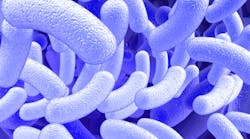RELATED: Dentists to address global concern over antimicrobial resistance at IDEM Singapore
Antimicrobial peptides (AMPs) are short peptides consisting of about 12 to 50 amino acids synthesized on ribosomes. They were first discovered on the skin of frogs, the lymph of insects, and human neutrophils. What is especially remarkable about these AMPs is their broad spectrum of antimicrobial activities against bacteria, viruses, fungi, and eukaryotic parasites. Since AMPs carry a positive charge (AMPs have also been known to be called cationic peptides), their main mode of action allows them to disrupt microbial membranes rich in phospholipids with a negative charge, as well as target nucleic acids, protein synthesis, and formation of cell walls. AMPs, along with their broad spectrum of activity, have other therapeutic properties as well: synergy with other antimicrobial agents, stability over a wide range of pH, wound repair capabilities and angiogenesis stimulation. AMPs also participate in a number of other immune functions, such as attracting dendritic cells and recruiting mast cells (highly useful for warding off and battling infections), and unlike antibiotics, AMPs have displayed long periods of time without any microbes developing a microbial resistance.
Researchers have been investigating AMPs for nearly 30 years as an alternative to the growing crisis of antibiotic resistance strains. The broadness of their spectrum, as well as their ability to specifically target certain peptide regions among various organisms, has given an incredibly strong interest to exercise its potential, thus paving the way for specifically targeted antimicrobial peptides (STAMP). For example, we can tweak our STAMP to selectively eliminate the pathogenic microbe without harming any of the healthy microbes in the oral environment. This is very similar to the concept of a homing missile. AMPs through modification are able to selectively target gram+ and gram- bacteria, fungi, some enveloped viruses, and remarkably antibiotic-resistant pathogens. Its implications are vast and far-reaching. The technology of STAMP could one day be generated to specifically target any desired bacterium. A great advantage of STAMP is the short length of the peptide, thereby allowing large reduction in costs in synthesizing the molecules compared to synthetic variants of naturally occurring antimicrobial peptides. Furthermore, it is possible to construct a STAMP with multiple targeting peptide heads attached to a fixed amino acid, thus maximizing its potential while reducing costs.
G10KHc, a highly effective STAMP prototype with Pseudomonas-selective activity displays enhanced killing speed and selectivity, along with sustained killing ability. Research has also gone into the development of a STAMP for Streptococcus mutans (an etiological agent of dental caries). Under the name C16G2, studies involving STAMP have shown to specifically eliminate Streptococcus mutans in both planktonic form and saliva-derived biofilm systems in less than one minute of exposure. Furthermore, biofilm that were free of Streptococcus mutans were shown to halt progression of dental caries, resist colonization of Streptococcus mutans, and leave indigenous micro flora protected. Also, fewer numbers of Streptococcus mutans indicated a higher pH, a pH that favors healthy micro flora and not that of cariogenic microbes. Lack of cariogenic bacteria also induced protection of enamel and the promotion of faster remineralization.
C16G2 is one of many STAMP molecules to be successful in the line of antimicrobial therapies. STAMP innovator Wenyuan Shi has stated that STAMP technology has the capabilities to wipe out tooth decay in our lifetime. If this holds true, STAMP can improve the oral health for millions of people while reducing billions of dollars in costs. Furthermore, this therapy may one day pave the way as an optional treatment for other diseases beyond the scope of the oral environment.
Case, C; Funke, B; Tortorra, G. Microbiology. An introduction (402, 470). San Francisco, CA: Pearson Education, 2010.
Jorge Rojas graduated from the dental hygiene program at Hostos Community College in May 2014. He is currently preparing to take the National Board Dental Hygiene Exam.






